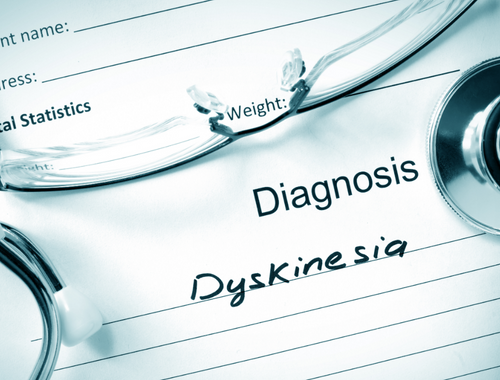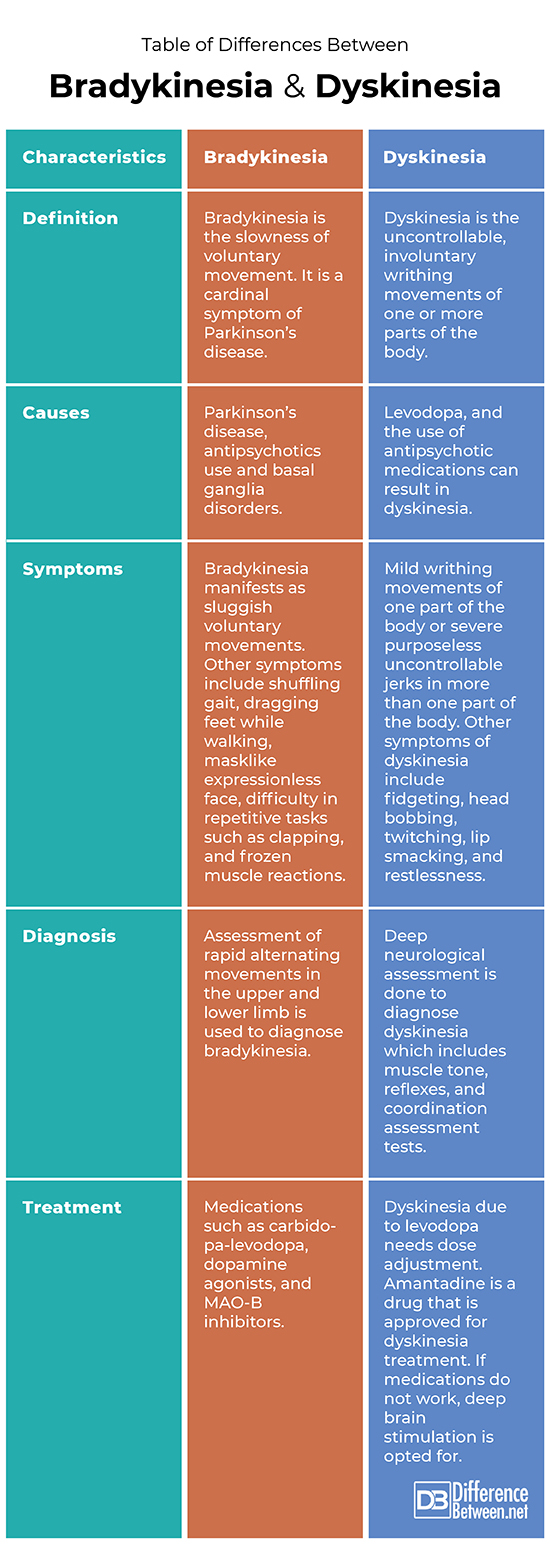Difference Between Bradykinesia and Dyskinesia
Bradykinesia is the slowness of voluntary movement. It is a cardinal symptom of Parkinson’s disease. Dyskinesia is the involuntary writhing movements of one or more parts of the body. Although it is not a key feature of Parkinson’s disease, it is commonly seen with the use of medications for the disorder.

What is Bradykinesia?
Definition: Bradykinesia is the sluggishness in voluntary, motor movements. The movements in bradykinesia are slow and sometimes frozen.
Causes: The exact cause of bradykinesia is not known. Bradykinesia is seen in Parkinson’s disease and with the use of certain drugs like antipsychotics. Basal ganglia disorders are also associated with bradykinesia.
Symptoms: Bradykinesia primarily presents as slow movements. However, there are other symptoms that are associated with the condition. These include shuffling gait, dragging feet while walking, masklike expressionless face, difficulty in repetitive tasks such as clapping, and frozen muscle reactions. In people with Parkinson’s disease, one of the most debilitating presentations of bradykinesia is the loss of speech. Bradykinesia also contributes to the risk of falling in people who have Parkinson’s disease.
Diagnosis: Assessment of rapid alternating movements in the upper and lower limb is used to diagnose bradykinesia. Finger tapping, supination pronation of the hand, toe-tapping, and heel tapping are assessed in these tests and a slow pace is observed.
Treatment: Symptoms of Parkinson’s cannot be cured completely. However, with medications like carbidopa-levodopa, dopamine agonists, and MAO-B inhibitors symptoms like bradykinesia can be controlled to a great extent. These medicines resemble dopamine to get the desired body response. In severe cases of Parkinson’s disease where medicines are ineffective, deep brain stimulation via electrodes can be tested.

What is Dyskinesia?
Definition: Dyskinesia is the uncontrollable, involuntary writhing movements of one or more parts of the body.
Causes: Levodopa-induced dyskinesia, as the name suggests is due to a medication called levodopa which is used in Parkinson’s disease patients. Tardive dyskinesia is another type of dyskinesia that is a side effect of antipsychotic medications.
Symptoms: Mild symptoms of dyskinesia include slight jerky movements of one part of the body. In severe cases, multiple parts of the body or sometimes the whole body move involuntarily. Other symptoms of dyskinesia include fidgeting, head bobbing, twitching, lip smacking, and restlessness.
Diagnosis: Deep neurological assessment is done to diagnose dyskinesia. It includes muscle tone, reflexes, and coordination assessment tests.
Treatment: Treatment for levodopa-induced dyskinesia includes dose adjustment and incorporating extended-release formulations into your regimen. Amantadine is a drug that is approved for dyskinesia treatment. If medications do not work, deep brain stimulation is opted for.
Difference between Bradykinesia and dyskinesia
- Definition: Bradykinesia is the slowness of voluntary movement. It is a cardinal symptom of Parkinson’s disease. Dyskinesia is the uncontrollable, involuntary writhing movements of one or more parts of the body.
- Causes: Bradykinesia is seen in Parkinson’s disease and with the use of certain drugs like antipsychotics. Basal ganglia disorders are also associated with bradykinesia. Levodopa, a drug used in Parkinson’s disease treatment, and the use of antipsychotic medications can result in dyskinesia.
- Symptoms: Bradykinesia manifests as sluggish voluntary movements. Other symptoms include shuffling gait, dragging feet while walking, masklike expressionless face, difficulty in repetitive tasks such as clapping, and frozen muscle reactions. Symptoms of dyskinesia vary with severity. These can be mild writhing movements of one part of the body or severe purposeless uncontrollable jerks in more than one part of the body. Other symptoms of dyskinesia include fidgeting, head bobbing, twitching, lip smacking, and restlessness.
- Diagnosis: Assessment of rapid alternating movements in the upper and lower limb is used to diagnose bradykinesia. Deep neurological assessment is done to diagnose dyskinesia which includes muscle tone, reflexes, and coordination assessment tests.
- Treatment: Bradykinesia is controlled by medications such as carbidopa-levodopa, dopamine agonists, and MAO-B inhibitors. Dyskinesia due to levodopa needs dose adjustment. Amantadine is a drug that is approved for dyskinesia treatment. If medications do not work, deep brain stimulation is opted for.
Table of differences between bradykinesia and dyskinesia

FAQs:
Is bradykinesia a type of dyskinesia?
No. Bradykinesia is slow movements whereas dyskinesia is uncontrollable, erratic involuntary movements.
What is the difference between Parkinson’s and dyskinesia?
Parkinson’s disease has bradykinesia as a key feature. Dyskinesia is uncontrollable involuntary movements and it is not a component of Parkinson’s disease.
What is the difference between dyskinesia and akinesia?
Dyskinesia is uncontrollable involuntary movements whereas akinesia is the inability to move the muscles voluntarily.
What are the five 5 signs of Parkinson’s disease?
Bradykinesia, postural instability, rigidity, resting tremors, and mask-like face are five signs of Parkinson’s disease.
What is the test for bradykinesia?
Assessment of rapid alternating movements in the upper and lower limb is used to diagnose bradykinesia.
What is an example of dyskinesia?
Fidgeting, writhing, and head bobbing are examples of dyskinesia.
What is the difference between dyskinesia and dystonia?
Dyskinesia is the involuntary writhing movements of one or more parts of the body whereas dystonia is involuntary muscle contractions.
- Differences Between Reptiles and Amphibians - May 17, 2024
- Difference Between Ophthalmology and Optometry - May 15, 2024
- Difference Between Fear and Anxiety - April 2, 2024
Search DifferenceBetween.net :
Leave a Response
References :
[0]Bologna, Matteo et al. “Evolving concepts on bradykinesia.” Brain : a journal of neurology vol. 143,3 (2020): 727-750.
[1]Heumann, Rolf et al. “Dyskinesia in Parkinson's disease: mechanisms and current non-pharmacological interventions.” Journal of neurochemistry vol. 130,4 (2014): 472-89.
[2]Berardelli, Alfredo, et al. "Pathophysiology of bradykinesia in Parkinson's disease." Brain 124.11 (2001): 2131-2146.
